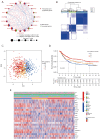Construction of ferroptosis and pyroptosis model to assess the prognosis of gastric cancer patients based on bioinformatics
- PMID: 39697712
- PMCID: PMC11651746
- DOI: 10.21037/tcr-24-683
Construction of ferroptosis and pyroptosis model to assess the prognosis of gastric cancer patients based on bioinformatics
Abstract
Background: Gastric cancer (GC) is a malignancy with a grim prognosis, ranking as the second most common cause of cancer-related deaths globally. Various investigations have demonstrated the substantial involvement of ferroptosis and pyroptosis in the advancement of tumors. Nevertheless, the precise molecular mechanisms by which distinct genes associated with ferroptosis and pyroptosis influence the tumor microenvironment (TME) in GC remain elusive. Therefore, this study aims to elucidate the role of ferroptosis and pyroptosis in GC and provide insigths for GC therapy and prognosis evaluation.
Methods: The data including gene expression, clinicopathological characteristics and survival information of GC samples from The Cancer Genome Atlas (TCGA) and Gene Expression Omnibus (GEO) cohorts were collected, and the expression level of ferroptosis and pyroptosis genes (FPGs) in GC samples were analyzed. Consensus clustering analysis, Cox logistic regression, principal component analysis (PCA), and the "survival", "survminer", "limma", "ggplot2" and other packages in R were utilized to compare the differences among different groups. In the level of GC cells, cell viability experiments were conducted by Cell Counting Kit-8 (CCK-8) assay.
Results: Through the analysis of the expression level of FPGs in GC samples from the TCGA and GEO cohorts, twenty-three prognostic-related and differentially expressed FPGs were collected for further analysis. Through consensus clustering analysis, three distinct patterns of FPGs were identified and found to be correlated with clinicopathological characteristics, immune cell infiltration, and prognosis in patients with GC. Subsequently, 684 prognostic-related genes from 1,082 pattern-related differentially expressed genes (DEGs) were screened for constructing the FPG_Score system to quantify FPGs patterns in individual GC patients and predict the prognosis. The analysis indicated that GC patients with high FPG_Score exhibited improved survival rates, increased tumor mutation burden (TMB), higher microsatellite instability (MSI), and elevated programmed cell death protein ligand 1 (PD-L1) expression. These patients with high FPG_Score were more likely to benefit from immunotherapy and had a more favorable prognosis.
Conclusions: Our study innovatively provided a comprehensive analysis of FPGs in GC, and constructed the FPG_Score system for stratification of individual patients, so as to predict its benefit from immunotherapy and prognosis.
Keywords: Gastric cancer (GC); ferroptosis; microsatellite stability; pyroptosis; tumor mutational burden.
2024 AME Publishing Company. All rights reserved.
Conflict of interest statement
Conflicts of Interest: All authors have completed the ICMJE uniform disclosure form (available at https://tcr.amegroups.com/article/view/10.21037/tcr-24-683/coif). G.W. is a member of the Adicon Clinical Laboratories, Inc. The other authors have no conflicts of interest to declare.
Figures









Similar articles
-
Identification of cuproptosis-related subtypes, construction of a prognosis model, and tumor microenvironment landscape in gastric cancer.Front Immunol. 2022 Nov 21;13:1056932. doi: 10.3389/fimmu.2022.1056932. eCollection 2022. Front Immunol. 2022. PMID: 36479114 Free PMC article.
-
Construction of a prognostic model for gastric cancer based on immune infiltration and microenvironment, and exploration of MEF2C gene function.BMC Med Genomics. 2025 Jan 14;18(1):13. doi: 10.1186/s12920-024-02082-4. BMC Med Genomics. 2025. PMID: 39810215 Free PMC article.
-
Autophagy-related prognostic signature characterizes tumor microenvironment and predicts response to ferroptosis in gastric cancer.Front Oncol. 2022 Aug 16;12:959337. doi: 10.3389/fonc.2022.959337. eCollection 2022. Front Oncol. 2022. PMID: 36052243 Free PMC article.
-
Prognostic Model and Immune Infiltration of Ferroptosis Subcluster-Related Modular Genes in Gastric Cancer.J Oncol. 2022 Oct 13;2022:5813522. doi: 10.1155/2022/5813522. eCollection 2022. J Oncol. 2022. PMID: 36276279 Free PMC article.
-
A novel RNA modification prognostic signature for predicting the characteristics of the tumor microenvironment in gastric cancer.Front Oncol. 2023 Feb 16;13:905139. doi: 10.3389/fonc.2023.905139. eCollection 2023. Front Oncol. 2023. PMID: 36874129 Free PMC article.
Cited by
-
Identification and single-cell analysis of prognostic genes related to mitochondrial and neutrophil extracellular traps in bladder cancer.Sci Rep. 2025 Jul 4;15(1):23982. doi: 10.1038/s41598-025-10413-3. Sci Rep. 2025. PMID: 40615671 Free PMC article.
-
Editorial: From bench to bedside in gastric cancer: diagnosis, prognosis, and treatment, volume II.Front Med (Lausanne). 2025 Mar 11;12:1562989. doi: 10.3389/fmed.2025.1562989. eCollection 2025. Front Med (Lausanne). 2025. PMID: 40134913 Free PMC article. No abstract available.
References
LinkOut - more resources
Full Text Sources
Research Materials
Miscellaneous
